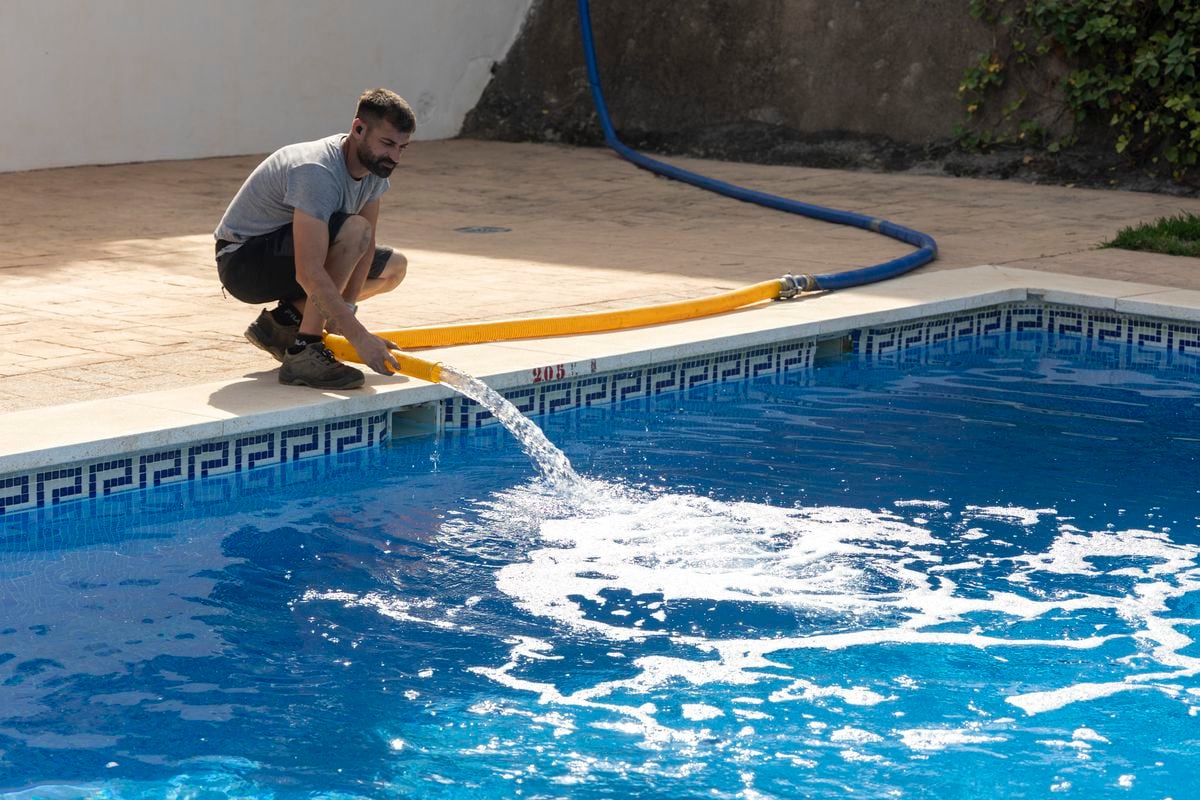A man walks through the Montbru de Moià Golf Club, in Moianès, this Thursday.Albert Garcia
Drought wreaks havoc in central Catalonia, a land of pastures and crops, halfway along the route that goes from Barcelona to the Pyrenees.
Moianès has barely eight years of life as a region, it was officially created in 2015, but its youth does not prevent it from suffering from poor health due to poor hydration.
The lack of water in several municipalities has made it necessary to enable tanker trucks to ensure that residents and companies have guaranteed water.
An emergency supply that puts the municipal budget in trouble.
Meanwhile, the regulation of the Generalitat to contain the drought gives the green light to maintain irrigation (with 50% restrictions) in the two golf courses in the region.
The levels of the Catalan reservoirs are at 27% and the Government warns that it is necessary to administer with the utmost rigor the scarce water reserves that still resist.
The low level of the aquifers negatively affects the quality of the water, something that has become a "worrying" problem in Moianès, as recently declared by the regional president, Ramon Vilar.
Nine of the ten municipalities in the region depend on their own wells because they are not connected to the general supply network of the Catalan Water Agency (ACA).
The wells are in a hurry and alternatives must be sought.
The municipality of Castellcir, with some 800 residents, has been using tanker trucks for "almost a year" to have water, explains its mayor, Eduard Guiteras.
"Four trucks a day inject 100,000 liters into the network."
A similar case happens in the small town of Granyena, and they are also aware of the problem in Castellterçol, with 2,600 inhabitants.
In the municipality of Castellterçol there is one of the two golf courses in Moianès.
The mayor, Isaac Burgos, points out that "for years the golf course made do with rainwater, but for the last three years it has used a well that it owns."
Burgos speaks knowingly because he was a member of the golf club, he states that he no longer pays the fee, and affirms that the course "makes good use of water."
but for the last three years he has used a well that he owns”.
Burgos speaks knowingly because he was a member of the golf club, states that he no longer pays the fee, and affirms that the course "makes good use of water."
but for the last three years he has used a well that he owns”.
Burgos speaks knowingly because he was a member of the golf club, states that he no longer pays the fee, and affirms that the course "makes good use of water."
In Moià, the capital of the region, there is another golf course.
"We have a 50% irrigation restriction," they say from the club.
The Ministry of Climate Action justifies that "practically all of the fields, if not all, use reclaimed water."
The reclaimed water comes from a primary treatment in the treatment plants.
In practice, there are golf courses, such as those of Moianès, which irrigate with water from their own wells.
“The municipalities cannot do anything.
We cannot prohibit it, just as we cannot prohibit people from filling swimming pools [despite the fact that the Generalitat decree does not allow it].
We can only resort to pedagogy”, says Eduard Guiteras, mayor of Castellcir.
He calculates that the consistory has spent "more than 300,000 euros" with the daily traffic of water tanks.
"It's unsustainable," he says,
and points out that the municipal budget is 1 million euros.
The trucks arrive at the town from Mollet del Vallès, after traveling a distance of 35 kilometres.
“Being able to get our water supply from a closer point would lower transportation costs,” he observes.
José Sánchez, a truck driver, manipulates the tank to supply the Castellcir municipal tank, in the Moianès region.Albert Garcia
"In 2019 we already commissioned a diagnosis of the water problems that the region has," highlights Sonsoles Letang, regional councilor in charge of the Territory area.
“That there are towns that already need to resort to vats before summer is very bad news,” she observes.
The region has several cattle farms, and the farms also suffer from a lack of water.
"A horse can drink 20 liters of water a day and a cow up to 40. There are farmers who have to go looking for water in wells outside their farms to be able to water their cattle."
The possibility of expropriation
The decree law against drought approved this Wednesday by the Government provides for "the temporary occupation and forced expropriation" of water supply networks.
Esquerra managed to approve it with difficulty.
The abstention of Junts, the PSC, En Comú Podem and the CUP gives Pere Aragonès room, who in Parliament has the support of just 33 deputies out of 135, to apply a battery of measures that they pursue, even with sanctions if necessary, cut back on water consumption.
The most severe restrictions affect 224 municipalities of the Ter-Llobregat system, which supplies Girona, Barcelona and its entire metropolitan area.
There are about 6 million people.
The Government alleges that Catalonia suffers the longest period without rain since records exist (1905).
You can follow EL PAÍS Catalunya on
and
, or sign up here to receive
our weekly newsletter
Subscribe to continue reading
Read without limits
Keep reading
I'm already a subscriber






/cloudfront-eu-central-1.images.arcpublishing.com/prisa/VXMZOX65ABHL7FVL43RBSELBZE.jpg)
/cloudfront-eu-central-1.images.arcpublishing.com/prisa/YVHMWL7DMVBDDK33L37HIKIMP4.jpg)







